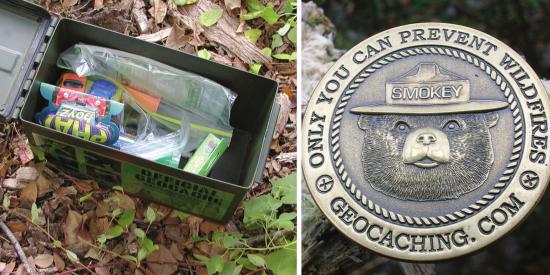High-Tech Treasure Hunt Geocaching Up North

What Is It?
Geocaching is best described as a real-world treasure hunting game. It happens in the great outdoors, and what you’re seeking are hidden waterproof containers that hold a logbook, pen or pencil, and various treasures.
When you find a geocache, you write your name in the logbook, and you may select a treasure item to keep (common geocache treasures, or swag, include unusual coins, CDs, books, or small trinkets such as action figures or ornamental buttons. Many geocachers also will leave an item behind as a trade and to mark that they were there.
Also common in caches are disposable cameras finders can use to capture and leave a photo of themselves, as well as tiny takeaway gadgets called hitchhikers, generally TravelBugs or GeoCoins that are trackable, enabling the person who placed the cache to track how far his or her hitchhiker gets.
In addition to the traditional geocache treasures described here, there are over a dozen variations, from puzzle games to webcam caches, in which the goal is to save a screen capture as proof of your finding the cache.
How Do You Do It?
GPS is your primary tool. Geocache websites offer geocache opportunities — often searchable by location, terrain, difficulty level, most popular cache sites, and more. Rather than sharing what the cache contains, the site simply tells you the longitude and latitude where you can find the cache you’ve selected. You input the coordinates of the cache into your GPS unit or GPS-enabled mobile phone, and then it’s up to you to plot out how you’ll get there, whether by foot, bicycle, car, boat, or horse.
Of course, you’ll want to be considerate of others as you go on your hunt. The informal Geocacher’s Creed asks participants to respect private property, minimize impact on nature, and avoid causing disruptions, endangering others, or causing public alarm.
Where Are Geocaches Found?
There are thousands upon thousands of geocaches hidden around the world and plenty right here in Northern Michigan.
Geocache locations can be as diverse as in a park, on a hiking or horse trail, hidden along a city street, buried in snow, or even underwater. Geocaches vary greatly in size and appearance from micro-caches (think film canister size) to mega-caches (a large lidded bucket, say).
Some cachers will even double-hide a cache by putting it in a fake rock or hollowed-out log with a hidden compartment.
Part of the fun is seeing how well cachers camouflage their cache container and, of course, the grand reveal: opening the container to see what’s inside and who’s already been at that particular location.
Why Participate?
You may not find a pirate chest full of treasure (although some caches do contain “FTF” items — aka, First to Find treasures — that are of higher value, such as DVDs, CDs, rare toys, or even money, and intended for the first person who finds it. But it’s the thrill of the hunt and a reason to get outdoors, exploring places you might not otherwise visit that’s made this activity such a popular one.

GEOCACHING IN NORTHERN MICHIGAN:
Want to try geocaching? Here are some links to get you started:
Geocaching (and the official Geocaching phone app) geocaching.com
The Michigan Geocaching Organization mi-geocaching.org
Straits Area Geocachers geo-cachers.com
Trail Link (click on Geocaching) traillink.com
Michigan Geocacher Road Rally geocacherenough.com
View On Our Website